Many of us have gotten used to believing that Mars is just another lonely, lifeless planet. True, its atmospheric conditions are just too extreme to be habitable by any life form that we know of.

The red planet (Photo credit: Wikipedia)
But that doesn’t make it an uninteresting planet at all. Through continuous advancements in technology, we’ve learned a lot about the red planet. Here are some of the most fascinating facts about Mars that you might not have known:
1. The planet started to captivate astronomers way back in the prehistoric times.
Mars was already sighted by Egyptian astronomers during prehistoric times. These people already knew back then that Mars is a moving object beyond the skies. They were also able to record many observations about the behavior and positions of other heavenly bodies.
2. Due to Mars’ red color, people in ancient times associated it with blood and war.
Mars is named after the Roman god of war (Ares in Greek mythology). Since the planet appears red in color, many ancient people associated the color with blood; hence, the association with war.
3. Mars’ red color is attributed to the prevalence of rustic dust on its surface.
Mars’ red color is caused by iron oxide (more commonly known as rust) dust, which is predominant on its surface. Mars’ surface is rocky and is composed of minerals like silicon, oxygen, and other elements. Tholeiitic basalt make up most of its surface, with some parts that are silica-rich.
4. Mars’ moons were named after the twin brothers of fear and terror in Greek mythology.

North polar ice cap on Mars (Photo credit: Wikipedia)
Mars has two identified moons, Phobos and Deimos.
Phobos is the larger and closer moon. It is named after the Greek god, Phobos, son of Mars.
Deimos, on the other hand, is named after the twin brother of Phobos. Both moons are irregularly shaped. In Greek mythology, Phobos was believed to be the personification of panic or fear, while Deimos terror or dread.
5. Mars is more similar to earth than any other planet in the solar system.
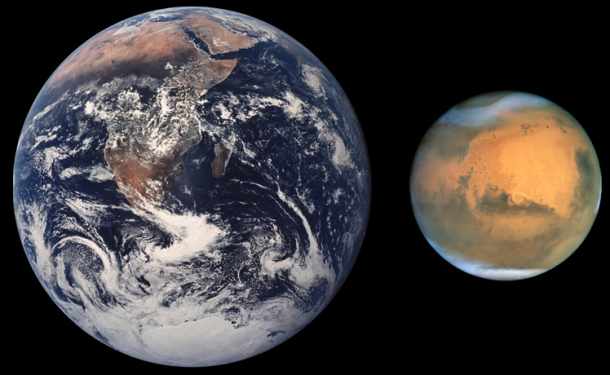
Mars size comparison to earth (Photo credit: Wikipedia)
Mars is smaller than Earth. Its diameter is approximately only half of Earth’s. Compared to Earth, it also has lesser density, volume, and mass.
6. Water does exist in Mars, albeit not in liquid form.

North polar ice cap on Mars (Photo credit: Wikipedia)
Water exists in Mars. However, it does not exist in liquid form but in solid state as water ice.
This is due to the atmospheric conditions and low temperature in Mars, where water cannot sustain being in fluid form. Water vapor also exists in small amounts in the atmosphere.
7. Mars’ atmosphere is made up of 95% carbon dioxide.
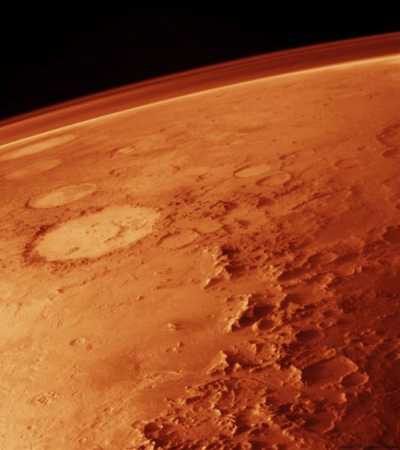
Mars' atmosphere (Photo credit: Wikipedia)
Mars’ atmosphere is so thin and is mostly made up of carbon dioxide. Humans definitely cannot breathe in Mars without the right space suit.
Also, the extremely low pressure and the absence of an ozone layer both make Mars an unsuitable place to live for humans.
8. Mars has four seasons like Earth does.
Mars, like earth, also has winter, spring, summer and fall. This is due to the similarity in both planets’ tilt of the rotation axis. The difference, however, is that each season in Mars lasts twice as long as that in Earth.
9. With the four seasons comes a wide range of temperature ups and downs.
Mars generally has a very cold temperature which could go down to -205o F in its winter season. However, the average temperature during summer is 72o F which is similar to summer temperatures in some places on Earth.
10. Mars has 24 hours in a day but 687 days in a year.
A day in Mars also lasts about 24 hours but a year lasts approximately 687 days
- almost twice the Earth’s. The Martian year is equivalent to its orbital period around the sun. Mars is farther away from the sun that is why its orbital period is longer.
11. Humans tend to “lose weight” in Mars.
A human being’s weight on Mars is equivalent to approximately two-fifths of his weight on Earth. This is because Mars’ gravitational pull is only 37.5% compared to that of the Earth’s. So if you weigh 50 kilos, you theoretically lose weight on Mars and only weigh about 20 kilos over there.
12. The solar system’s highest peak is nestled in Mars.
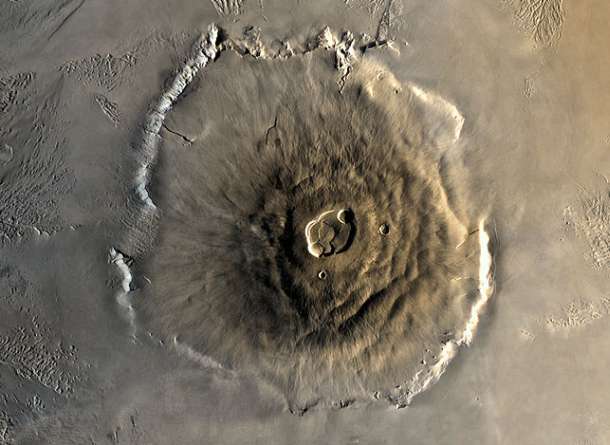
Olympus mons (Photo credit: Wikipedia)
The Olympus Mons (Mount Olympus) is more than three times the height of Earth’s Mount Everest. It is a type of volcano that is built almost completely of fluid lava flows. It is both the tallest mountain and largest volcano in the whole solar system.
13. Mars drew itself nearest to Earth on August 27, 2003.
This is the closest-at a distance of under 55.76 million kilometers- Mars has been to Earth in approximately 60 millennia. The next time such proximity will happen will be in 2287. Variations in proximity are due to the elliptical orbits of both Earth and Mars. The distance may range variably between 54 to 103 million kilometers.
14. The largest and most violent dust storms happen on Mars.
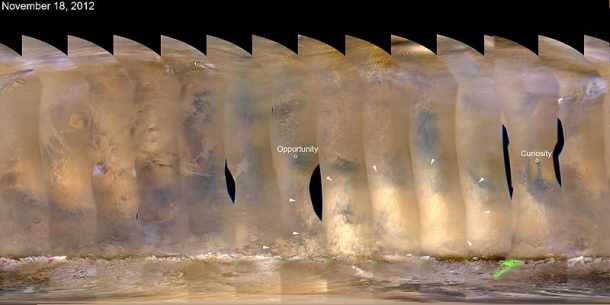
Satellite images of Martian dust storms, as indicated by the white arrows (Photo credit: Wikipedia)
The typical dust storms have winds at about 125 mph. They last for long periods and cover the whole planet. Dust storms occur when Mars is nearest to the sun. During dust storms, the temperature on Mars’ atmosphere increases because the dust clouds absorb the sun’s heat instead of deflecting it.
15. Mars is also home to the longest and deepest canyon in the entire solar system.
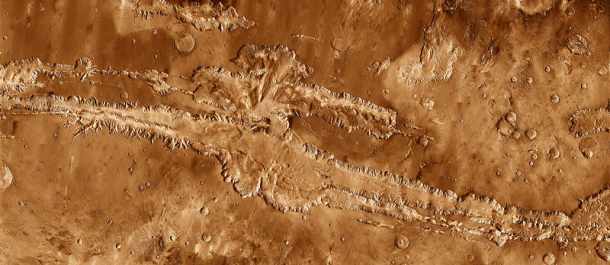
Valles Marineris (Photo credit: Wikipedia)
Valles Marineris on Mars is the longest and deepest canyon in the solar system. It is 4,000 km long (almost as long as the USA), 200 km wide at points, and up to 7 km deep. The network of interconnected valleys covers almost one-fourth of the planet’s circumference and more than half of its diameter.
16. Bits and pieces of Mars can be found on Earth.
A number of meteorites identified to have been formed in Mars were found in different places on Earth. Scientists believe that these meteorites were blasted off from Mars, possibly due to an asteroid’s or comet’s strong impact, and eventually landed here on Earth. These meteorites exhibit exceptional similarities to those found by spacecrafts sent to Mars. These meteorites may also be the gateway to discovering if life really existed in Mars periods ago.
17. The Mars symbol symbolizes the male gender.
This symbol, which is a circle with a tilting arrow to the upper right, is believed to represent the shield and spear of the war god Mars (Roman) / Ares (Greek).
18. Mars is a favorite subject in many fictional works.
Several science fiction movies, novels, short stories, television shows, comics, and even computer and video games are depicted on Mars. The Martian is one of the most illustrated science fiction characters. One example is Looney Tunes' prominent character, Marvin the Martian.
19. Antarctica’s physical conditions resemble that of Mars, although not as harsh.

Antarctica (Photo credit: Wikipedia)
Antarctica’s deserts almost resemble the physical conditions of Mars. It is the closest you can get to knowing how it feels like to be in Mars. Unfortunately, even the most extreme conditions in Antarctica cannot equal the actual environment of the Red Planet. Unlike Mars, Antarctica is still able to sustain some forms of life.
20. The first colored pictures of Mars were taken in 1976.
The Viking Landers captured the first colored pictures of Mars in 1976. Viking 1 was the first spacecraft from Earth to successfully land in one functional piece on the surface of Mars on July 20, while Viking 2 closely followed on September 3 in the same year. On the other hand, Mariner 4 was the first spacecraft to capture non-colored photographs of Mars.
21. Mars is the most studied planet.

The Curiosity rover (Photo credit: NASA)
This is due to Mars’ accessibility and proximity to Earth.
Unlike the other planets whose surfaces are hidden by clouds, Mars does not have a cloud layer. The keen interest on Mars is also due to the preliminary hope of being able to discover life on the planet.
22. Spacecrafts sent to Mars may permanently remain in the planet.
Spacecrafts sent to Mars never come back to Earth. Normally, a Martian rover from Earth does not need to return. Gathered data is concurrently transmitted back to Earth; hence, a rover or spacecraft may permanently remain in Mars.
23. No human being has set foot on Martian soil.
Unlike the historical leap of having sent Neil Armstrong and Buzz Aldrin to the moon via Apollo 11, no human being has ever set foot on Mars yet. Rest assured, scientists are incessantly studying and preparing for this momentous breakthrough.
24. It takes approximately 16 months to travel from Earth to Mars and back.
It takes approximately eight months to travel to Mars and another eight months to return to Earth. Therefore, a complete voyage to Mars may require about two years. If one travels to Mars by a car running at a speed of 60 mph, it would take a little over 270 years to get there and more than 220 years to travel back to Earth.
25. Mars could potentially be “terraformed” to suit the needs of future human inhabitants.
Scientists are eyeing on Mars as a future relocation site for the ever-growing human population. As the human race exponentially grows, the time may come when Earth can no longer sustain its inhabitants. The human population may outgrow Earth’s capacity. One possible solution to this forecasted dilemma is terraforming Mars to some extent so that it can sustain human life. It may not be possible as of now, but scientists are constantly working on simulations of Mars’ physical conditions to learn further about its feasibility and sustainability as a possible new home for the Earthlings.